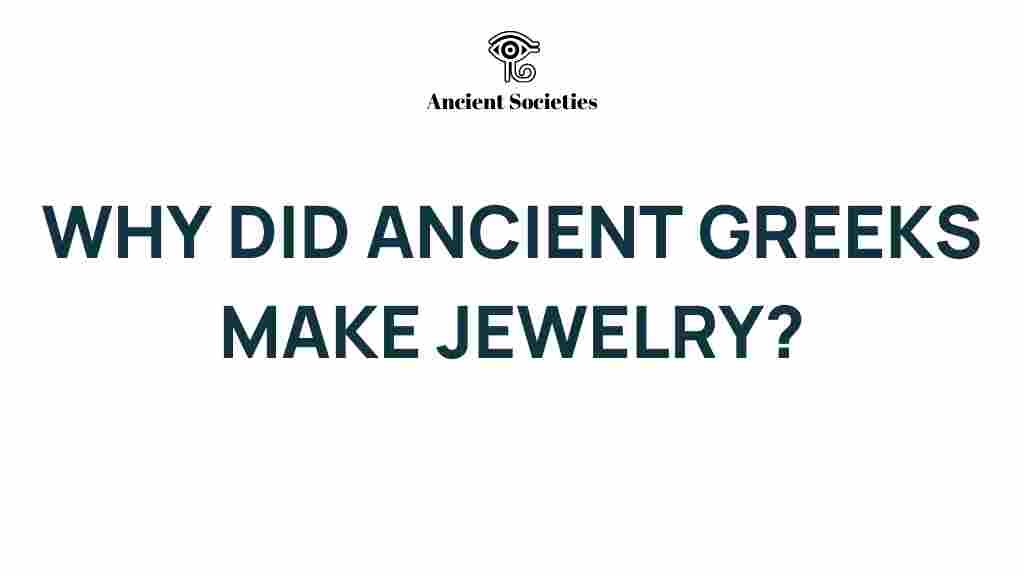Unveiling the Allure: The Fascinating Reasons Behind Ancient Greek Jewelry
Jewelry has always been an essential part of human culture, serving not just as adornment but also as a reflection of one’s status, beliefs, and artistry. In Ancient Greece, jewelry was no exception. The exquisite craftsmanship, rich symbolism, and historical significance of Ancient Greek jewelry continue to captivate enthusiasts and historians alike. This article delves into the allure of Ancient Greek jewelry, exploring its cultural context, intricate designs, and the artisans behind these treasures.
The Cultural Significance of Jewelry in Ancient Greece
Jewelry in Ancient Greece transcended mere decoration. It played a pivotal role in various aspects of life, including religion, social status, and personal expression. Here are some key cultural aspects:
- Religious Significance: Jewelry often featured motifs associated with deities, such as Athena and Aphrodite, symbolizing protection and beauty.
- Social Status: The type and quality of jewelry indicated wealth and rank within society, with the elite donning more elaborate pieces.
- Rituals and Ceremonies: Jewelry was commonly used in weddings, funerals, and other significant life events, enhancing the wearer’s status and connection to tradition.
The Craftsmanship Behind Ancient Greek Jewelry
The artisans of Ancient Greece were highly skilled, utilizing techniques that have influenced jewelry making throughout history. The craftsmanship involved in creating these pieces was meticulous and required a deep understanding of materials and design. Key techniques included:
- Lost-Wax Casting: This method allowed artisans to create complex shapes and intricate designs by casting molten metal into molds made from beeswax.
- Filigree Work: Thin threads of gold or silver were twisted and arranged to create delicate patterns, adding a layer of elegance to the jewelry.
- Granulation: Tiny granules of gold were fused to a surface to create intricate textures and designs.
Symbolism in Ancient Greek Jewelry
The symbolism embedded in Ancient Greek jewelry reflects the values and beliefs of Greek culture. Various motifs and designs carried significant meaning:
- Nature Motifs: Designs featuring leaves, flowers, and animals symbolized fertility and connection to the earth.
- Geometric Patterns: These designs represented order, harmony, and the cosmos, important concepts in Greek philosophy.
- Mythological Figures: Jewelry often depicted gods and goddesses, serving both aesthetic and devotional purposes.
Types of Jewelry in Ancient Greece
Ancient Greek jewelry came in various forms, each serving different purposes and reflecting different aspects of life:
- Necklaces: Often made of gold or beads, these were worn by both men and women and were sometimes adorned with pendants.
- Earrings: Gold hoop and drop earrings were popular, with designs ranging from simple to elaborate.
- Rings: Used as symbols of status or love, rings were often engraved with seals or images of deities.
- Bracelets: Worn around the wrist, these could be solid or flexible and were often richly decorated.
Historical Context of Ancient Greek Jewelry
The history of Ancient Greek jewelry is intertwined with the evolution of Greek society. From the Geometric period to the Hellenistic era, jewelry styles and techniques evolved significantly:
The Geometric Period (c. 900-700 BC)
During this time, jewelry was relatively simple, often featuring geometric shapes. The use of bronze and the introduction of gold marked the beginning of more intricate designs.
The Archaic Period (c. 700-500 BC)
Jewelry became more ornate, with the incorporation of figures and natural motifs. The craftsmanship improved, and the use of techniques like granulation began.
The Classical Period (c. 500-323 BC)
Jewelry reached new heights of sophistication. Artisans created detailed pieces that embodied the ideals of beauty and symmetry, often inspired by the human form.
The Hellenistic Period (c. 323-30 BC)
Following Alexander the Great’s conquests, jewelry saw a fusion of styles from different cultures. The designs became more elaborate, featuring intricate scenes and detailed workmanship.
Step-by-Step Process of Creating Ancient Greek Jewelry
The creation of Ancient Greek jewelry was a labor-intensive process that involved several steps:
- Design: Artisans would sketch designs, considering the balances of symmetry and symbolism.
- Material Selection: Choices were made regarding the type of metal, gemstones, and additional materials to be used.
- Crafting Techniques: Techniques such as casting, filigree, and engraving were employed to bring the design to life.
- Finishing Touches: Polishing and additional embellishments were added to enhance the piece’s beauty.
Modern Interpretations and Influences
The legacy of Ancient Greek jewelry continues to influence modern designers. Contemporary artisans draw inspiration from the intricate designs and symbolism of Ancient Greece:
- Resurgence of Classic Designs: Many contemporary jewelry pieces reflect the styles of Ancient Greece, featuring similar motifs and craftsmanship.
- Symbolic Jewelry: Modern pieces often incorporate symbols like the laurel wreath, reminiscent of Greek heritage.
- Artisan Techniques: Many artisans today still employ traditional techniques, preserving the craftsmanship of the past.
Troubleshooting Tips for Collectors of Ancient Greek Jewelry
For those interested in collecting Ancient Greek jewelry, here are some tips to ensure authenticity and quality:
- Research: Familiarize yourself with the styles and characteristics of genuine Ancient Greek jewelry.
- Seek Expert Advice: Consult with historians or appraisers who specialize in Ancient artifacts.
- Examine Materials: Ensure that the materials used are consistent with those available in ancient times, such as gold, silver, and semi-precious stones.
Conclusion: The Timeless Allure of Ancient Greek Jewelry
Ancient Greek jewelry is more than just beautiful adornment; it is a testament to the culture, craftsmanship, and symbolism of a civilization that has profoundly influenced the world. From its rich history to its intricate designs, the allure of Ancient Greek jewelry continues to inspire and fascinate. Whether you are an admirer, a collector, or a student of history, understanding the depth of meaning behind these treasures enhances the appreciation of their beauty.
To explore more about the fascinating world of ancient artifacts, visit this resource. For additional insights on jewelry styles throughout history, check out this article.
This article is in the category Culture and created by AncientSocieties Team
